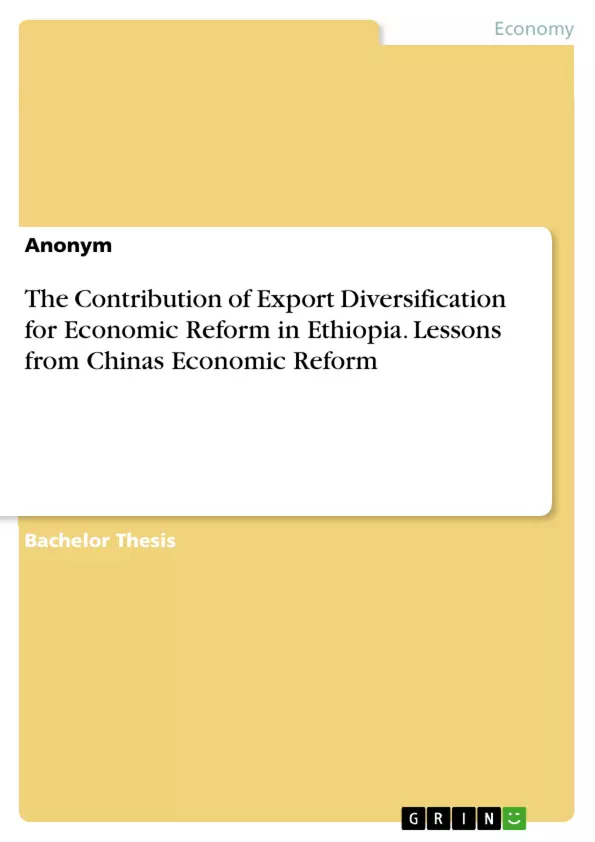Export diversification on financial boom has been a controversial problem in the empirical literature for a long time. The motive behind this paper is to analyze, why Ethiopia battles to promote and diversify its exports and what are the engines of impressive boom of China’s foreign trade, assuming any; lessons can Ethiopia take from Chinas foreign exchange journey, since it has been the most profitable developing nation in this contemporary generation of globalization.
The issue of accelerated financial increase has been the principal agenda in economic coverage formula for most of the Sub-Saharan Africa (SSA) and different developing nations of the world. The records of the financial overall performance of most SSA counties show off that they had been performing higher earlier than their colonial independence than today.
The economic boom of existing day developed countries like the United States, Canada, Australia and New Zealand is mostly attributed to international exchange. International exchange has been given a great deal significance in the policy formulation of many LDC. Maddison (2007) and Mkandawire & Unies (2004) contended that International exchange has additionally performed a vital position in the historical development of the third world countries. South Korea, Taiwan, Hong Kong and Singapore have been generally attributed to the overall performance of the exterior sector. Ethiopia has actively pursued the import- substitution industrialization approach in the course of the Imperial and Derg regimes. After the fall of the Dergue regime, however, the contemporary regime initiated trade liberalization. An empirical investigation to discover out the contribution of exports to economic growth is very integral part.
Export diversification has been the concern of most developing nations such as Ethiopia. Despite such a concern, few developing nations in East and South East Asia have managed to attain a diversified export shape with increased extent of manufactures. Diversification and structural transformation play vital roles in influencing the macroeconomic overall Performance of low-income countries (LICs) Diversification in exports and in domestic manufacturing has been conducive to faster economic boom in LICs. Accelerated diversification is additionally associated with decrease output volatility and larger macroeconomic stability.
Inhaltsverzeichnis (Table of Contents)
- Abstract
- Introduction
- Ethiopia's Foreign Trade and Export Policy
- Ethiopia Export performance
- Evolution of Ethiopian Trade policy
- Evolution of Chinas Trade development policies
- Import substitution and Marginal Export promotion
- Export promotion neutralizing import substitution (1984-1990)
Zielsetzung und Themenschwerpunkte (Objectives and Key Themes)
This paper examines the challenges Ethiopia faces in promoting and diversifying its exports, drawing lessons from China's remarkable foreign trade growth. It seeks to understand the drivers of China's export success and identify potential strategies for Ethiopia to emulate.
- Export Diversification in Ethiopia
- Lessons from China's Economic Reform
- Impact of Trade Policy on Economic Growth
- Role of Foreign Direct Investment (FDI) in Exports
- Importance of Infrastructure and Exchange Rate Policy
Zusammenfassung der Kapitel (Chapter Summaries)
The paper begins with an overview of Ethiopia's export performance, highlighting its historical underperformance despite recent improvements. The chapter explores the evolution of Ethiopia's trade policy, from import substitution to trade liberalization.
The study then delves into the evolution of China's foreign exchange policy from a trade and development perspective. It examines China's transition from import substitution to export promotion, outlining the key policy shifts and their impact on economic growth.
The paper further explores the role of import substitution and marginal export promotion in China's early economic development. It analyzes the limitations of the import substitution approach and the subsequent shift toward export-oriented policies.
Finally, the chapter examines the period of export promotion neutralizing import substitution in China, emphasizing the ongoing influence of import substitution policies on economic development.
Schlüsselwörter (Keywords)
The paper focuses on the key concepts of export diversification, economic reform, trade policy, and lessons learned from China's economic growth. It also explores themes like import substitution, export promotion, foreign direct investment, and the impact of infrastructure and exchange rate policy on economic performance.
- Citar trabajo
- Anonym (Autor), 2020, The Contribution of Export Diversification for Economic Reform in Ethiopia. Lessons from Chinas Economic Reform, Múnich, GRIN Verlag, https://www.grin.com/document/987697



